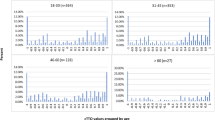Abstract
Purpose
EQ-5D tariffs are typically based on general population valuations studies, but whether valuations of experienced health (EH) or hypothetical health (HH) are more appropriate is disputed. Previous comparisons of valuations of EH and HH have focused on absolute differences in dimension-specific regression coefficients. We examined differences in the relative importance attributed to the EQ-5D dimensions between EH and HH valuations of EQ-5D states in the United States.
Methods
We used the regression model from the US EQ-5D valuation study on EH ratings from the 2000–2003 Medical Expenditure Panel Survey and on HH ratings from the US EQ-5D valuation study conducted in 2001. We then compared patterns in the relative magnitudes of coefficients that corresponded to the five dimensions.
Results
In the HH model, self-care and pain/discomfort were the most important dimensions, while usual activities were the least important. In the EH model, usual activities were the most important dimension, while self-care was one of the least important.
Discussion
The findings reveal considerable differences between stated preferences for HH and ratings of EH, particularly for self-care and usual activities. The findings accentuate the importance of the debate about which groups’ values should be used in medical priority setting.



Similar content being viewed by others
References
Drummond, M. F. (2007). Methods for the economic evaluation of health care programmes. Oxford [u.a.]: Oxford University Press.
Gold, M. R. (1996). Cost-effectiveness in health and medicine. USA: Oxford University Press.
Dolan, P. (1997). Modeling valuations for EuroQol health states. Medical Care, 35(11), 1095–1108.
Shaw, J. W., Johnson, J. A., & Coons, S. J. (2005). US valuation of the EQ-5D health states: Development and testing of the D1 valuation model. Medical Care, 43(3), 203–220.
Ubel, P. A., Loewenstein, G., & Jepson, C. (2003). Whose quality of life? A commentary exploring discrepancies between health state evaluations of patients and the general public. Quality of Life Research, 12(6), 599–607.
De Wit, G. A., Busschbach, J. J., & De Charro, F. T. (2000). Sensitivity and perspective in the valuation of health status: Whose values count? Health Economics, 9(2), 109–126. Available at: [Accessed July 20, 2010].
Brazier, J., Akehurst, R., Brennan, A., et al. (2005). Should patients have a greater role in valuing health states? Applied Health Economics and Health Policy, 4(4), 201–208.
Mann, R., Brazier, J., & Tsuchiya, A. (2009). A comparison of patient and general population weightings of EQ-5D dimensions. Health Econmics, 18(3), 363–372. Available at: [Accessed April 29, 2010].
EuroQol Group. (1990). EuroQol–a new facility for the measurement of health-related quality of life. Health Policy, 16(3).
Cohen, J. W., Cohen, S. B., & Banthin, J. S. (2009). The medical expenditure panel survey: A national information resource to support healthcare cost research and inform policy and practice. Medical Care, 47(7_Supplement_1):S44–S50. doi:10.1097/MLR.0b013e3181a23e3a.
Brazier, J., Deverill, M., & Green, C. (1999). A review of the use of health status measures in economic evaluation. Journal of Health Service Research & Policy, 4(3), 174–184.
Yu, W. W., & Machlin, S. R. (2005). An examination of skewed health expenditure data from the Medical Expenditure Panel Survey (MEPS). Journal of Economic and Social Measurement, 30(2/3), 127.
Machlin, S. R., Zodet, M. W., & Nixon, J. L. (2003). Estimates of medical expenditures from the Medical Expenditure Panel Survey: Gains in precision from combining consecutive years of data. In: Joint Statistical Meetings: Section on Survey Research Methods. Available at: http://www.amstat.org/sections/srms/proceedings/y2003/Files/JSM2003-000537.pdf.
Powdthavee, N. (2009). What happens to people before and after disability? Focusing effects, lead effects, and adaptation in different areas of life. Social Science & Medicine, 69(12), 1834–1844.
Author information
Authors and Affiliations
Corresponding author
Rights and permissions
About this article
Cite this article
Rand-Hendriksen, K., Augestad, L.A., Kristiansen, I.S. et al. Comparison of hypothetical and experienced EQ-5D valuations: relative weights of the five dimensions. Qual Life Res 21, 1005–1012 (2012). https://doi.org/10.1007/s11136-011-0016-3
Accepted:
Published:
Issue Date:
DOI: https://doi.org/10.1007/s11136-011-0016-3




